Build Your Own Wind Generator: A Fun Guide
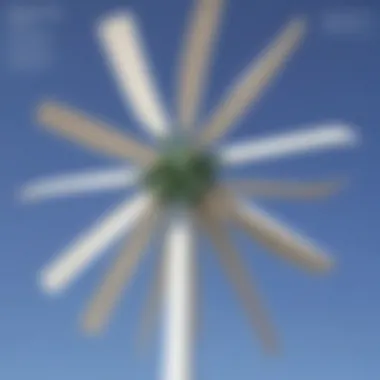
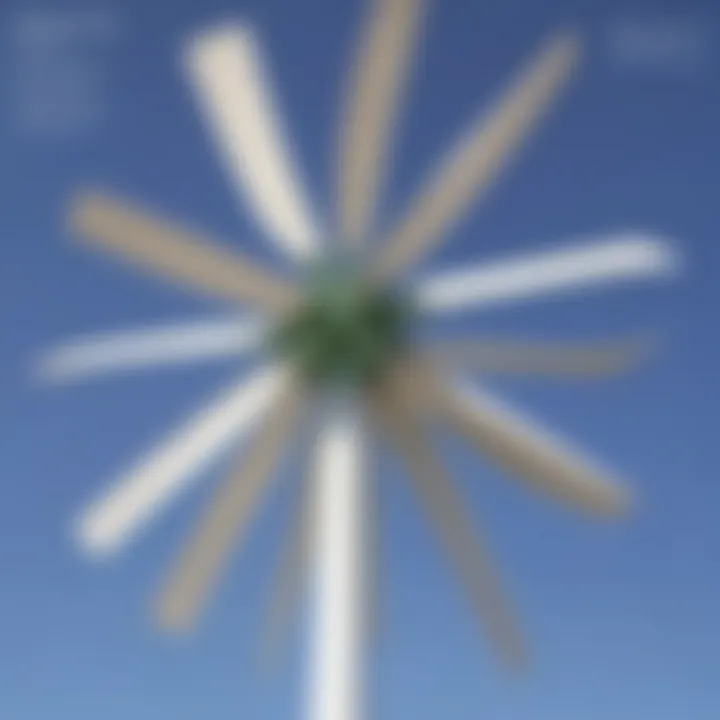
Intro
In an age where technology and nature intertwine, understanding renewable energy becomes essential. One of the most accessible forms of renewable energy for young minds to explore is wind energy. By constructing a homemade wind generator, children can directly engage with this concept in a practical way. This project not only promotes learning about energy principles but also nurtures creativity and critical thinking.
Wind energy harnesses the power of moving air to produce electricity. It serves as a clean alternative to fossil fuels, emphasizing the importance of sustainability. Through this guide, we will take young science enthusiasts through the steps of building their own wind generator, explaining the underlying scientific principles in a simple and clear manner.
Science Fun Facts
Exploring wind energy can be exciting and full of intriguing information. Here are some fun facts that may be of interest:
- Wind is everywhere: Did you know that every location experiences wind? Its strength and direction can change constantly.
- Wind energy is ancient: Sailboats used wind energy for thousands of years. People have been capturing wind for practical use for centuries.
- Efficiency: Modern wind turbines can convert up to 45% of wind energy into electricity, making them very efficient.
"Wind energy is neither new nor an untested technology. It has been utilized for many centuries, just look at how people used sails on boats."
- Global reach: Countries like Denmark get nearly 47% of their electricity from wind energy. This proves that wind can be a powerful resource.
These snippets spark curiosity and can help young builders understand the importance of wind energy in both history and modern times. Through engaging in this project, they can see firsthand how wind can be transformed into useful electricity.
Interesting Trivia and Facts
- Speed Matters: Wind needs to blow at least 3 miles per hour for turbines to generate power effectively.
- Nature’s Fluctuation: Wind patterns can change based on different factors like temperature and geography.
- Less Footprint: Wind generators typically have a smaller carbon footprint compared to traditional power sources.
Quirky Science Stories
- Have you heard about the world’s largest wind turbine? It stands nearly 800 feet tall and can provide electricity for thousands of homes.
- There was once a famous race involving setups of homemade wind turbine generators. Kids from different schools competed to see whose turbine could produce the most electricity!
This fun knowledge not only entertains but also educates young enthusiasts, preparing them for the hands-on experience to come.
Intro to Wind Energy
Wind energy is a significant and promising source of renewable energy. It utilizes the natural movement of air to generate electricity. Understanding wind energy is essential for young science enthusiasts, as it opens a window to the study of renewable resources, environmental responsibility, and innovation. This section lays the groundwork for building a homemade wind generator by introducing fundamental concepts related to wind energy.
What is Wind Energy?
Wind energy is the process of converting the kinetic energy of wind into usable electrical power. Wind turbines capture wind's movement through their blades that start rotating when wind blows. This rotational energy turns a generator, which transforms it into electricity. It is an efficient and clean source of energy.
Wind energy can be harnessed in various ways, but turbines are the most common. The key aspect is that this energy source is plentiful; wind is everywhere and can be found in both urban and rural settings.
Importance of Renewable Energy Sources
Renewable energy sources, like wind, are vital for several reasons:
- Environmental Impact: Using renewable energy helps reduce greenhouse gas emissions.
- Sustainability: Wind is a resource that will not run out, unlike fossil fuels.
- Energy Independence: Countries can generate their own power, reducing reliance on imported fuels.
- Economic Growth: Investing in wind energy can create jobs and stimulate local economies.
It is crucial for young minds to appreciate the significance of these energy sources as they contribute to a healthier planet. Exploring how to harness wind energy fosters critical thinking and scientific curiosity. Each of these points sets a foundation for understanding the project of creating a homemade wind generator.
Basic Principles of Wind Generators
Understanding the basic principles of wind generators is crucial for grasping how they function and their significance in renewable energy. This section explains their workings and the different types of wind generators that are available. Such knowledge lays a foundation for young science enthusiasts, guiding them through their DIY projects and enhancing their curiosity about wind energy.
How Wind Generators Work
Wind generators convert wind energy into mechanical energy, which is then transformed into electrical energy. The process begins when wind moves against the blades of the generator. The motion of the blades spins a rotor, which is connected to a generator.
Inside the generator, the rotor's spinning motion causes movement in a magnetic field. This movement generates electricity. The key point here is that the energy produced depends on the wind speed and the design of the wind generator itself. If the wind blows fast, the generator produces more electricity, demonstrating the simplicity and effectiveness of harnessing wind energy.
Types of Wind Generators
Wind generators can be categorized into two main types: Horizontal Axis Wind Turbines and Vertical Axis Wind Turbines. Understanding these types helps in making a choice based on specific needs and conditions.
Horizontal Axis Wind Turbines
Horizontal Axis Wind Turbines (HAWT) are the most common type of wind generator. They typically resemble traditional windmills, with blades that rotate around a horizontal axis. One significant aspect of HAWTs is their efficiency—these turbines can capture wind energy effectively, especially when placed in open areas with fewer obstructions.
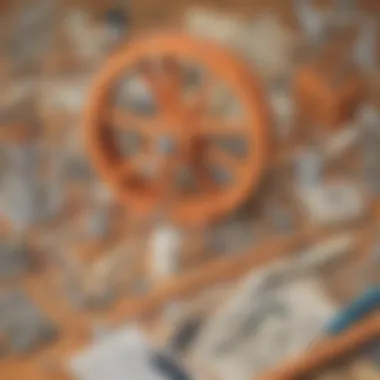

The key characteristic of HAWTs is their ability to adjust direction based on wind changes. This feature, known as yawing, allows them to optimize energy capture. However, HAWTs may require more space and can be mechanically complex due to their design. This complexity can pose challenges in maintenance and installation, but they are popular because they yield more energy than some alternatives.
Vertical Axis Wind Turbines
Vertical Axis Wind Turbines (VAWT) stand apart due to their vertical design. Unlike HAWTs, VAWTs can capture wind from any direction without needing to rotate. Their unique feature is the ability to work in turbulent winds, which makes them suitable for urban settings or areas with less consistent wind patterns.
A key advantage of VAWTs is their simplicity and lower installation costs. They are often smaller than HAWTs and require less maintenance. However, they can be less efficient in generating electricity, especially in high-wind environments. Nonetheless, they can be an appealing choice for educational projects, as they demonstrate different engineering concepts in renewable energy development.
"Knowing the different types of wind generators helps young minds select the best fit for their projects and understand their operational principles better."
In summary, understanding how wind generators work and recognizing the types available enables young science enthusiasts to appreciate the practicality of renewable energy. This insight not only informs their projects but also deepens their appreciation for sustainable energy solutions.
Materials Required for a Homemade Wind Generator
Understanding the Materials Required for a Homemade Wind Generator is crucial in the process of building your own wind generator. Proper selection and preparation of materials not only enhance the efficiency but also ensure the overall safety and functionality of the project. Young science enthusiasts will find that these materials are accessible and can be sourced from various places. The process of gathering these items can also be an educational experience, teaching kids about resourcefulness and planning.
Essential Components
To build an effective homemade wind generator, certain core components must be collected. Here is a breakdown of these essential parts:
- Generator: This is the heart of your wind turbine. A DC motor can often be used as a generator when wired correctly. Look for small motors from old toys or appliances.
- Rotor Blades: These are crucial for capturing wind energy. Different materials can be used to create rotor blades, such as PVC pipes or balsa wood. These materials are lightweight and easy to shape.
- Tower: A sturdy tower is needed to elevate the rotor blades. You can use metal pipes, PVC pipes, or wood. Ensure it can withstand the wind forces.
- Base: A stable base prevents the generator from falling over in strong winds. This can be constructed from thick wood or concrete blocks.
- Battery: Batteries store the energy generated. Lead-acid or lithium batteries can be used, depending on availability and budget. Safety in handling batteries should be emphasized.
- Wiring: Proper electrical wires are necessary to connect the generator to the battery and other components. Be sure to choose wires that can handle the expected current.
Using these components efficiently is key to building a successful wind generator. Each piece serves a defined purpose, and their proper assembly results in a functional device that converts wind energy into electrical energy.
Tools Needed
To assemble your homemade wind generator, you will also need some basic tools. These tools will help ensure that the assembly is done correctly and efficiently. Here is a concise list of the necessary tools:
- Drill: Needed for making holes in various materials to assemble the generator.
- Screwdriver: For fastening screws into place, ensuring everything is secure.
- Saw: Either a hand saw or a power saw will be needed to cut materials to the desired shape.
- Wrenches: Useful for tightening bolts, especially on the tower and base design.
- Wire Cutters: Essential for trimming electrical wires to the appropriate length.
- Measuring Tape: To measure components accurately before cutting or placing.
Gathering these tools before beginning the assembly will streamline the process and make it more enjoyable. Having an organized workspace not only aids in efficiency but also promotes safety by keeping tools easily accessible.
"The right materials and tools pave the way for a successful and safe wind generator project."
Step-by-Step Assembly Instructions
The section on assembly instructions is crucial for understanding how to build a homemade wind generator. It breaks down the process into manageable steps. With clear guidance, young science enthusiasts can learn essential skills while experimenting with renewable energy concepts. By following these instructions, learners can see how each component works together, enhancing their grasp of wind energy. Successful assembly also builds confidence in their ability to tackle scientific projects.
Building the Base and Tower
The base and tower form the backbone of the wind generator. A sturdy foundation is essential for stability. The aim is to create a structure that can withstand strong winds without toppling over. Generally, wood or metal is used for the base. Using a wooden plank, lay down a solid foundation about 60 cm by 60 cm. It must be heavy enough to resist the wind forces.
For the tower, materials such as PVC pipes or metal poles are common. For a vertical wind generator, the height should be around 1.5 meters or more. This height helps capture wind more effectively. Make sure to attach the tower securely to the base with brackets or screws. This prevents any movement that could cause failures later.
Constructing the Rotor Blades
Rotor blades are critical components that harness wind energy and convert it into rotational motion. Their design can vary, but commonly six blades made from lightweight materials offer the best performance. To create the blades, consider using plastic or thin wood. Each blade should be approximately 60 cm long and about 10 cm wide.
Cut the blades to shape, making them slightly curved for better aerodynamics. Attach the blades equally spaced around a central hub. A well-constructed rotor maximizes efficiency by catching more wind. Use screws or strong adhesive to secure the blades in place.
Assembling the Generator
The generator converts the motion from the rotor into electrical energy. Begin with a DC motor, which serves as the heart of the generator. Connect the rotor to the shaft of the motor. It is essential to ensure they are fixed tightly for optimal functioning.
Mount the motor on the tower, keeping it elevated for improved wind exposure. You can use brackets or metal supports to hold the motor. Securely fasten all connections. A well-assembled generator plays a pivotal role in the overall efficiency of the wind generator.
Wiring and Connection
Wiring connects the components and ensures they work together effectively. Begin by preparing wires for the setup. Keep a multimeter handy for measuring voltage and ensuring correct connections. Attach the motor's output terminals to a charge controller if you plan to store electricity.
Make sure to use insulated wires to prevent any short-circuits. Connect the wires from the rotor to the generator. Also, secure a voltage regulator if your setup involves various devices. Sound wiring practices are crucial for the safety and effectiveness of the wind generator.
Final Adjustments
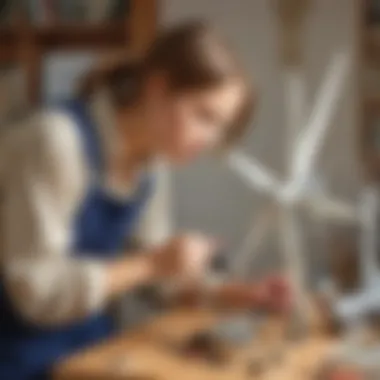

Once the assembly is complete, final adjustments are necessary to optimize performance. Check all connections, ensuring they are tight and secure. Adjust the angle of the rotor if possible to maximize wind catch.
Additionally, test the generator by exposing it to wind. Monitor the voltage output and ensure it meets expectations. This step is vital for confirming that everything is working correctly. If problems arise, revising the assembly is essential to successful operation.
Important: Always prioritize safety during the assembly process. Wearing appropriate gear, like gloves and goggles, can prevent accidents.
Following these step-by-step assembly instructions can help young science enthusiasts achieve valuable insights into the workings of renewable energy technology.
Safety Considerations
When embarking on a project like building a homemade wind generator, safety should never be overlooked. Engaging in hands-on science experiments comes with responsibilities. Ensuring that both young builders and their supervising adults are aware of safety protocols can drastically reduce the risk of accidents. Here are some vital elements about safety considerations:
- Understanding Risks: Children may not fully realize the potential dangers involved in handling tools or working with electricity. Educating them about what to watch out for is paramount.
- Creating a Safe Workspace: A cluttered or disorganized area can lead to accidents. Establishing a clean, dedicated workspace minimizes unnecessary distractions.
- Supervised Work: Adult supervision is crucial during the entire process. This ensures that children are guided safely and correctly through each step.
Incorporating these safety measures not only protects young enthusiasts but also fosters a responsible approach to working with tools and technology.
Handling Tools Safely
Using tools can be exciting but also dangerous if not managed properly. Children must learn to treat tools with respect. Here are some key points to consider:
- Choose the Right Tools: Each task requires specific tools, such as screwdrivers, pliers, or saws. Ensure that the tools are appropriate for the task at hand.
- Always Use Protective Gear: Safety glasses, gloves, and even ear protection can prevent injuries. Encourage children to wear these items every time they work with tools.
- Proper Tool Handling: Teach children how to grip and maneuver tools correctly. This knowledge reduces the chance of slips and accidents.
"The best tool for the job is one that is used safely!"
These practices not only enhance safety but promote positive habits for future projects.
Working Outdoors
Building a wind generator usually involves outdoor work. Being outside can pose its own safety challenges, so it is important to take some considerations into account:
- Check the Weather: Before starting, look at the forecast. Working in unstable or severe weather can be dangerous. Choose a nice, calm day to work.
- Stay Hydrated and Sun-Safe: Spending time outside can lead to dehydration or sunburn. Encourage taking breaks to drink water and using sunscreen.
- Designate a Safe Area: Set up a specific area where tools and materials are kept. This prevents tripping hazards and helps maintain organization.
Above all, ensure that safety remains the priority when working outdoors. This instills a respect for nature and an understanding of the elements involved in renewable energy projects.
Testing Your Wind Generator
Testing your wind generator is a crucial part of the construction process. It helps ensure that your efforts have resulted in a functional device capable of harnessing wind energy. Testing also provides valuable insights into how well your design performs under various conditions. This section will discuss the importance of selecting the right location for your generator and how to measure wind speed effectively.
Find the Right Location
Choosing the ideal location for your wind generator can significantly affect its performance. Here are a few key points to consider when selecting a site:
- Open Space: Your wind generator should be placed in an open area, away from tall buildings or trees that could block wind flow. This will maximize its exposure to wind.
- Wind Patterns: Observe the wind patterns in different seasons. Some areas may receive consistent winds, while others might experience fluctuations. Ideally, test your generator in a place where the wind blows steadily.
- Safety Distance: Ensure that your generator is positioned at a safe distance from public spaces or walkways. This minimizes the risk of accidents due to falling debris or mechanical failures.
In addition, try to avoid locations where the ground is uneven. Level ground can help stabilize your generator, leading to better performance and safety.
Measuring Wind Speed
To determine the effectiveness of your wind generator, measuring wind speed is essential. Understanding how fast the wind is blowing allows you to assess if the wind conditions are suitable for generating electricity. Here’s how to do it:
- Use an Anemometer: One of the best tools to measure wind speed is an anemometer. There are digital and mechanical models available. A digital one might be more accurate for young science enthusiasts.
- Record Readings: Take multiple measurements throughout the day. Wind speeds can change quickly, so it's important to gather a range of data. Record your findings at different times to identify patterns.
- Compare and Analyze: Once you have collected enough data, compare it with the specifications of your wind generator. This can help you evaluate whether adjustments in design or location are needed.
"Finding the right location and measuring wind speed are essential steps to ensure your wind generator operates at peak performance."
By carefully choosing the location and accurately measuring wind speed, you can gain a better understanding of how well your homemade wind generator will function. Not only will this process inform improvements, but it will also enhance your learning experience regarding renewable energy.
Understanding the Output
Understanding the output of a homemade wind generator is vital to grasping how this project translates physical effort and wind into usable electricity. This section will cover how electricity is generated, how it can be used, and practical examples that young science enthusiasts can relate to. The real-world applications are essential for fostering both curiosity and understanding about renewable energy.
Electricity Generation
Electricity generation through wind energy involves converting kinetic energy from the wind into electrical energy. When the wind turns the rotor blades, the generator converts that movement into electricity. This process hinges on several elements, most notably the size of the blades and the wind speed. Bigger blades can capture more wind, leading to greater energy production. Conversely, even a small wind generator can be effective in moderate wind conditions.
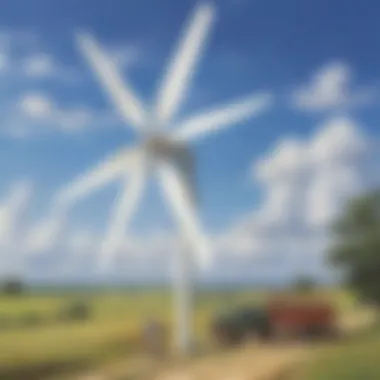
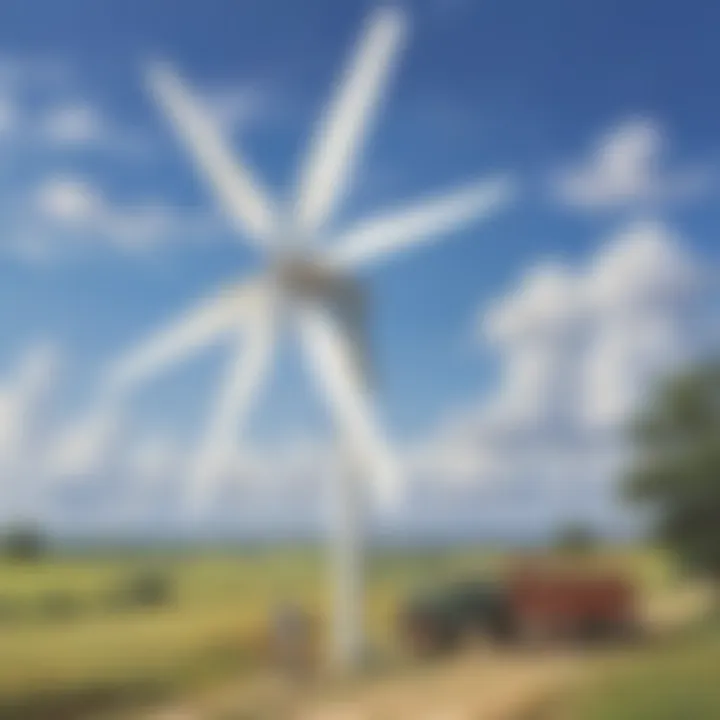
Wind generators operate on a simple but effective principle: conversion of movement into energy. With an understanding of how wind turbines function, young builders will appreciate the fine details of energy collection. The output can vary significantly depending on the components used and local wind conditions.
Using the Generated Power
Using the electricity produced by a homemade wind generator provides practical experience in energy management. Understanding different ways to harness this energy can motivate children to learn more about technology and sustainable practices. There are multiple applications, two of which will be discussed here: Lighting and Charging Devices.
Lighting
Lighting is one of the most visible applications of wind-generated electricity. When kids see their homemade generator powering a light bulb, it becomes a tangible expression of their efforts. The key characteristic of this aspect is simplicity; a light bulb can illuminate with straight-forward connections. It serves both educational and entertaining purposes.
The unique feature of using wind energy for lighting lies in its sustainable nature. Light provided by wind generators does not rely on fossil fuels, reducing carbon footprint. However, there are disadvantages; if wind conditions are poor, the light may not operate continuously. Understanding these limitations can encourage problem-solving and adaptability in young learners.
Charging Devices
Chargings devices with output from a wind generator is increasingly relevant in today’s technology-driven world. This portion of using generated power allows young enthusiasts to connect their projects to everyday life. Kids can learn how to charge batteries or small electronic devices including flashlights or mobile phones.
The critical feature of charging devices is versatility. This activity shows that the energy generated is not merely a concept but something that can power real gadgets. Each device behaves differently based on energy needs and can educate about energy consumption.
A unique aspect of utilizing this power for charging devices is the need for effective energy storage solutions. The generated electricity must be stored in batteries to be used later, which opens up discussions on energy conservation and efficiency. However, one downside is that charging might take longer if wind conditions aren't ideal, leading students to learn about patience and planning.
"Understanding the real-world implications of energy generation helps students connect academic knowledge with practical applications."
By focusing on electricity generation and its uses, this guide ensures that young learners not only build and understand their wind generator but also appreciate its role in a broader energy landscape.
Common Challenges and Solutions
Building a homemade wind generator is an exciting yet complex project that may come with difficulties. Acknowledging these common challenges is crucial for a successful experience. Solutions are often straightforward if you approach them with curiosity and problem-solving skills. In this section, we will discuss low wind conditions and mechanical issues, two challenges that may arise during your wind generator project.
Low Wind Conditions
Low wind conditions can be frustrating when working on your wind generator. Sometimes, you may find that your setup generates less power than expected, or in some cases, no power at all. This can happen when winds are too weak to turn the rotor blades effectively.
To address low wind conditions:
- Choose the Right Location: Make sure your generator is situated in an area where wind flows freely. Avoid placing it near tall buildings or trees, which can obstruct wind.
- Adjust the Height: Elevating your wind generator, if possible, can help. Higher positions can capture stronger winds that are often present higher above the ground.
- Optimize Blade Design: Rotor blades should be lightweight and have an efficient design to catch any available wind. Experiment with different shapes or materials to improve performance.
Remember, patience is key. Monitoring wind data in your area can inform your choices and help to find the best times for testing.
Mechanical Issues
Mechanical issues can arise in any engineering project. Your homemade wind generator may face several problems, such as misalignment, friction, or wear in components. When any of these occur, the performance can suffer, limiting the generator's output.
To mitigate mechanical issues:
- Regular Maintenance: Check all parts regularly. Tighten screws and bolts that may come loose during use. This prevents unnecessary wear and enhances performance.
- Lubricate Moving Parts: Use an appropriate lubricant on rotating parts. Lubrication helps minimize friction, allowing for smoother operation and extended lifespan.
- Calibrate the System: Ensure that the rotor blades are correctly aligned with the wind direction. Misalignment can lead to decreased efficiency or stalled movement.
Address these mechanical challenges promptly to ensure your wind generator operates effectively.
"Innovation often stems from overcoming obstacles. Each challenge faced can lead to better understanding and improved designs."
In summary, being aware of and prepared for common challenges, such as low wind conditions and mechanical issues, can make your journey of building a wind generator less daunting. With careful planning and maintenance, you can enhance the performance of your homemade wind generator.
Expanding Knowledge on Wind Energy
Understanding wind energy is critical for young science enthusiasts. Knowledge about this renewable resource fosters their curiosity about how nature can be harnessed for power. In a time where sustainable solutions are necessary for our planet, education in this area has great importance.
Wind energy is not merely an abstract concept; it is a practical application that shapes our future. By learning about wind generators, children can learn about the conversion of kinetic energy into electrical energy, which is a fundamental principle of physics. This hands-on experience not only teaches them about energy production but also enhances their problem-solving skills, as they face challenges in building the generator.
Useful Resources and Further Reading
To deepen their understanding of wind energy and its applications, children can benefit from various resources. Here are some notable options:
- Books on Renewable Energy: There are many books tailored for children which explain renewable energy concepts in engaging ways. Look for titles that include activities or experiments related to wind energy.
- Educational Websites: Websites like Wikipedia and Britannica provide comprehensive articles that simplify complex topics.
- Documentaries and Videos: Many platforms, including YouTube, have educational videos that visually explain how wind power is generated and used. These can help visual learners grasp essential ideas.
Exploring Other Renewable Energy Projects
Expanding knowledge in wind energy can also lead to interest in other renewable energy projects. Exploring a variety of energy sources encourages critical thinking and adaptability. Here are a few ideas:
- Solar Power: Building a simple solar oven or solar panel system can introduce concepts of photovoltaics and solar energy harnessing.
- Hydropower: Creating a small water wheel can explain how moving water generates energy, mirroring the principles of wind.
- Biomass Energy: Simple projects that utilize organic materials can show how waste can be turned into energy.
Each project emphasizes the significance and versatility of renewable energy. By engaging with these topics, children not only learn about environmental awareness but also about innovation in science and technology. As they explore, they become informed citizens who may contribute to future advancements in energy sustainability.







